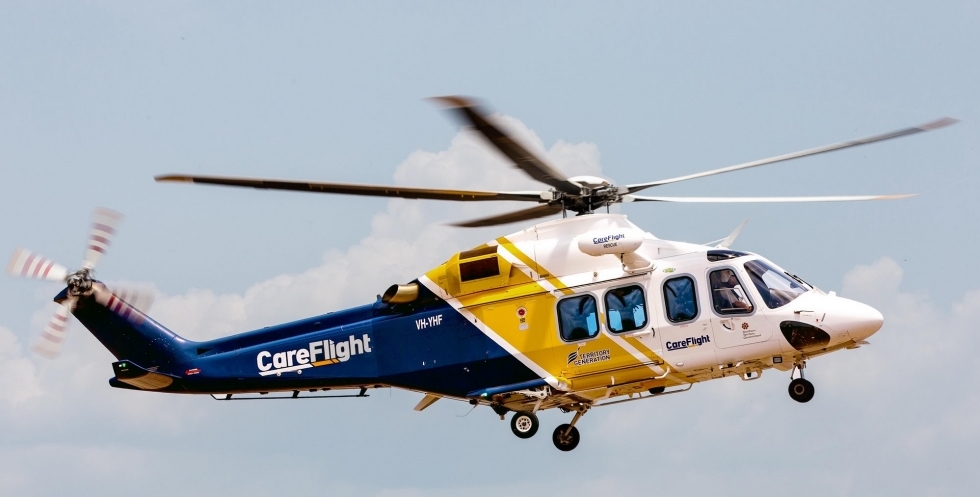
An AW139 helicopter experienced an uncommanded high rate of descent during a search for a recreational fishing vessel while the crew was flying with the aid of night vision goggles in bushfire-affected low visibility conditions at night.
An ATSB investigation into the 13 May 2018 incident found the pilot, who was flying under night visual flight rules, lost visual cues while descending to 400 feet above ground level to confirm the potential source of a transmitting EPIRB beacon, in the vicinity of Salt Water Arm, approximately 40 km east of Darwin. The pilot’s intent was to decrease rate of descent and airspeed before activating the helicopter autopilot’s auto-hover (HOV) mode at 400 ft above ground level (AGL), however at the point of ‘HOV’ mode activation, the AW139 was descending at over 1,300 feet per minute.
The aircrew officer, who was also using night vision goggles and was monitoring the descent from the helicopter’s main cabin, alerted the pilot over the intercom of the high rate of descent, before calling ‘Climb! Climb! Climb!’
The crew’s use of standard patter and practiced drills allowed them to recover the situation and avert an accident.
By this point the pilot had clear visual cues and also detected the rapid rate of closure with the ground, and instituted a recovery in accordance with drilled emergency procedures, overriding aircraft automatics and using forward cyclic and collective to reverse the rate of descent.
The aircraft descended to a height of 31 feet AGL before attaining a positive rate of climb. Occupied with flying the recovery procedure – flying solely through the outside picture and the attitude indicator – the pilot did not observe a main transmission torque limit exceedance message.
The helicopter safely recovered to Darwin, and subsequently returned to the Salt Water Arm area on a second flight to conduct a successful search for the source of the EPRIB transmission, found to be a small recreational fishing boat.
Describing the effect of smoke on pilots, ATSB Director Transport Safety Stuart Macleod said “During the approach to hover in a degraded visual environment, searching outside for visual cues drew the pilot’s attention away from the flight instruments. This resulted in flight instruments not being referenced when they were needed.
“With the aircrew officer in the helicopter’s main cabin, in anticipation of having to operate the winch, rather than next to the pilot in the cockpit, this negated the benefit of having a trained and competent crewmember to assist the pilot, resulting in a degraded monitoring capability in the approach to hover.”
Application of good crew resource management and practiced recovery techniques supported the crew in restoring control, Mr Macleod noted.
“The crew’s use of standard patter and practiced drills allowed them to recover the situation and avert an accident.”
When on the ground at Darwin, the crew could not confirm indications of the main gearbox overtorque exceedance, and a maintenance message was not detected on the crew alert system, which displays messages regarding the operation and condition of the aircraft for crew information and action. As a result, the helicopter was flown on the second sortie that evening, despite the overtorque exceedance requiring the AW139 to be grounded until the engine and airframe manufacturers could assess the helicopter as serviceable.
In reference to the uncommanded high rate of descent, Mr Macleod said the incident underlines the need for pilots to be aware of the human factors hazards associated with a loss of visual references.
“Pilots can protect themselves by maintaining the use of instrument scans in approaches at night, and making use of monitoring by trained and available crewmembers,” he said. “Instrument flight rules (IFR) pilots in IFR-rated aircraft should prioritise the use of inadvertent instrument meteorological conditions drills and pre-planned exit routes over recovery of visual meteorological conditions.”
The investigation also highlighted that flight crew and engineering teams should not rely solely on indicators, or the absence of indicators, to determine airworthiness.
“If there is any reason to suspect that aircraft limits have been exceeded, operators should run diagnostics to determine the airworthiness of the aircraft beyond doubt,” Mr Macleod said.
Since the incident the helicopter’s operator, CareFlight, introduced three new risk controls to prevent a similar occurrence, including updating standard operating procedures with stabilised approach criteria to require an immediate go-around if the aircraft leaves a prescribed range of parameters, and improved auto hover functions advice. In addition, the ground-based training syllabus now incorporates controlled flight into terrain avoidance training.
The investigation also noted that the EPIRB was not registered to its current owner and was incorrectly placed in the boat, causing the beacon’s signal to be scattered and leading to a loss of accuracy in the helicopter’s direction-finding equipment. As a result, the mission’s complexity and time taken to rescue were increased.


